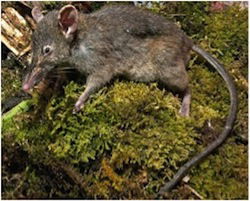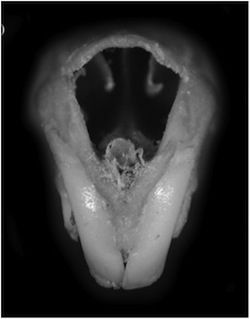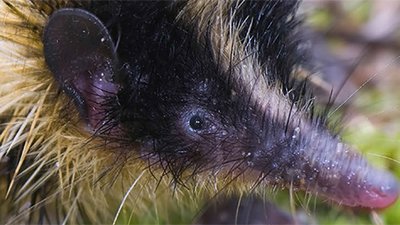Shrew-Like Rodent Evolving Backwards?
Backing off back teeth—is this shrew-like rodent evolving backwards?
News Source
- Yahoo! News–UK: “Unique’ New Rat Species Discovered”
Is it a rat? Is it a shrew? It’s a Paucidentomys vermidax, recently discovered in the rainforest of Indonesia’s Sulawesi Island. The shrew-rat’s long face and pointed snout resemble that of true shrews. Its unusual teeth have earned it notoriety as the next step in rodent evolution.

This newly discovered species lacks the usual dental equipment of rodents but survives quite nicely on a plentiful supply of earthworms in its Indonesian rainforest hideaway. But is it, as the media reports, “a new step in rodent evolution”? Image from uk.news.yahoo.com

These are the upper incisor teeth of the newly discovered variety of vermivorous (worm-eating) shrew-rat, Paucidentomys vermidax. Its discoverers note that its front teeth are even more delicate and pointy than those of other shrew-rats, and unlike other rodents, are not equipped for gnawing but are perfectly equipped for eating the numerous worms in their Philippine and Indonesian environments. Image from supplementary material supplied by the authors at rsbl.royalsocietypublishing.org.
The other 2,200 known rodent species have incisors in the front as well as molars in the back of their mouths and are generally well-equipped for gnawing. Paucidentomys vermidax has unusual bicuspid incisors1—useless for gnawing but good for gripping—and no molars for chewing. It lives on earthworms. Appropriately, its Latin name means “few-toothed, worm-eating mouse.”
Reporting in Biology Letters, Jacob Esselstyn and colleagues write, “Stomach contents from a single specimen suggest that the species consumes only earthworms. We posit that by specializing on soft-bodied prey, this species has had no need to process food by chewing, allowing its dentition to evolve for the sole purpose of procuring food. Thus, the removal of functional constraints, often considered a source of evolutionary innovations, may also lead to the loss of the very same traits that fuelled evolutionary diversification in the past.”2
Kevin Rowe, one of the discoverers, says, “This is an example of how species, when faced with a new ecological opportunity, in this case an abundance of earthworms, can evolve the loss of traits that were wildly successful in previous circumstances.”
Indonesian co-author Anang Achmadi, adds, “The specialised incisors of rodents give them the distinct ability to gnaw—a defining characteristic of rodents worldwide. In having lost all teeth except a pair of unusually shaped incisors that are incapable of gnawing, this new rat is unique among rodents.”
Rodents ordinarily have chisel-like incisors kept sharp for gnawing because they grow continuously and have enamel only on the front surfaces. Thus, most rodents sharpen their teeth while gnawing .
Seven other shrew-rat species are native to Sulawesi Island and to Luzon Island in the Philippines. Evolutionary scientists believe they independently evolved to match their wormy habitat.3 Missing much or all of their tooth enamel, their delicate front teeth are also unsuited for gnawing. And instead of the usual rat-quota of three molars in each back-quadrant of their mouths, they may have only one or two small ones.4 Shrew-rats, with extremely long faces suited for catching dinner, are well-adapted vermivores—worm-eaters—and have no need to chew.5
What makes this particular shrew-rat, Paucidentomys vermidax, unique is the somewhat pointy shape of its front teeth and the lack of molars. Careful examination reveals the sockets for molars are present but not the teeth.6
Despite the assertion that this creature demonstrates evolution, it didn’t evolve into a new kind of animal. As a rodent, it may have lost some genetic information for standard issue rodent choppers, but that makes it simply a variation within one of the rodent kinds God originally created. It is not a transitional rodent. It is not evolving into a non-rodent. It’s just a variety of shrew-rat with extreme versions of the qualities common to shrew-rats. And losing genetic information is not a path to gain genetic information to fuel upward evolution of new kinds of creatures.
Further Reading
For More Information: Get Answers
Remember, if you see a news story that might merit some attention, let us know about it! (Note: if the story originates from the Associated Press, FOX News, MSNBC, the New York Times, or another major national media outlet, we will most likely have already heard about it.) And thanks to all of our readers who have submitted great news tips to us. If you didn’t catch all the latest News to Know, why not take a look to see what you’ve missed?
(Please note that links will take you directly to the source. Answers in Genesis is not responsible for content on the websites to which we refer. For more information, please see our Privacy Policy.)
Footnotes
- Not "fang-like" as reported by the yahoo.com journalist. J. Esselstyn et al. “Evolutionary novelty in a rat with no molars” Biology Letters published online 22 August 2012 doi: 10.1098/rsbl.2012.0574
- Ibid.
- Ibid.
- Ibid.
- Ibid.
- Ibid.
Recommended Resources

Answers in Genesis is an apologetics ministry, dedicated to helping Christians defend their faith and proclaim the good news of Jesus Christ.
- Customer Service 800.778.3390
- © 2024 Answers in Genesis







